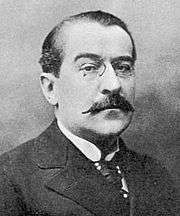Émile Picard
| Émile Picard | |
|---|---|
 | |
| Born |
24 July 1856 Paris, France |
| Died |
11 December 1941 (aged 85) Paris, France |
| Nationality | French |
| Fields | Mathematics |
| Institutions | University of Paris |
| Alma mater | École Normale Supérieure |
| Doctoral advisor | Gaston Darboux |
| Doctoral students |
Sergei Bernstein Lucien Blondel Gheorghe Calugareanu Paul Dubreil Jacques Hadamard Gaston Julia Traian Lalescu Philippe Le Corbeiller Paul Painlevé Mihailo Petrović Simion Stoilow Ernest Vessiot Henri Villat André Weil Stanisław Zaremba |
| Known for |
Picard functor Picard group Picard theorem Picard variety Picard–Lefschetz formula Picard–Lindelöf theorem Painlevé transcendents |
| Notable awards | Fellow of the Royal Society[1] |
Charles Émile Picard ForMemRS[1] (French: [ʃaʁl emil pikaʁ]; 24 July 1856 – 11 December 1941) was a French mathematician. He was elected the fifteenth member to occupy seat 1 of the Académie française in 1924.[2] [3]
Biography
Picard's mathematical papers, textbooks, and many popular writings exhibit an extraordinary range of interests, as well as an impressive mastery of the mathematics of his time. Modern students of complex variables are probably familiar with two of his named theorems. Picard's little theorem states that every nonconstant entire function takes every value in the complex plane, with perhaps one exception. Picard's great theorem states that an analytic function with an essential singularity takes every value infinitely often, with perhaps one exception, in any neighborhood of the singularity. He made important contributions in the theory of differential equations, including work on Picard–Vessiot theory, Painlevé transcendents and his introduction of a kind of symmetry group for a linear differential equation. He also introduced the Picard group in the theory of algebraic surfaces, which describes the classes of algebraic curves on the surface modulo linear equivalence. In connection with his work on function theory, he was one of the first mathematicians to use the emerging ideas of algebraic topology.
In addition to his theoretical work, Picard made contributions to applied mathematics, including the theories of telegraphy and elasticity. His collected papers run to four volumes.
Like his contemporary, Henri Poincaré, Picard was much concerned with the training of mathematics, physics, and engineering students. He wrote a classic textbook on analysis and one of the first textbooks on the theory of relativity. Picard's popular writings include biographies of many leading French mathematicians, including his father in law, Charles Hermite.
See also
Bibliography
- Picard, Émile (1891–1896). Traité d'Analyse. Paris: Gauthier-Villars et fils. OCLC 530823.[4]
- Picard, Émile (1905). La science Moderne et son état Actuel. Paris: E. Flammarion. OCLC 43307396.
- Picard, Émile (1922). La Théorie de la Relativité et ses Applications à l'astronomie. Paris: Gauthier-Villars. OCLC 1025334.
- Picard, Émile (1922). Discours et Mélanges. Paris: Gauthier-Villars. OCLC 4855336.
- Picard, Émile (1931). Éloges et Discours Académiques. Paris: s.n. OCLC 13473598.
- Picard, Émile (1978–1981). Œuvres de Ch.-É. Picard. vol. I–IV. Paris: Centre National de la Recherche Scientifique. OCLC 4615520.
References
- 1 2 Hadamard, J. (1942). "Emile Picard. 1856–1941". Obituary Notices of Fellows of the Royal Society. 4 (11): 129–126. doi:10.1098/rsbm.1942.0012.
- ↑ "Charles Émile Picard". MacTutor Archive. Retrieved June 12, 2005.
- ↑ Émile Picard at the Mathematics Genealogy Project
- ↑ Craig, T. (1893). "Picard's Traité d'Analyse". Bull. Amer. Math. Soc. 3 (2): 39–65. doi:10.1090/s0002-9904-1893-00166-3.